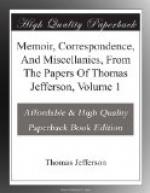Previous to the late revolution, most of the States were in the habit, whenever they had occasion for more money than could be raised immediately, by taxes, to issue paper notes or bills, in the name of the State, wherein they promised to pay to the bearer the sum named in the note or bill. In some of the States, no time of payment was fixed, nor tax laid to enable payment. In these, the bills depreciated. But others of the States named in the bill the day when it should be paid, laid taxes to bring in money enough for that purpose, and paid the bills punctually, on or before the day named. In these States, paper money was in as high estimation as gold and silver. On the commencement of the late Revolution, Congress had no money. The external commerce of the States being suppressed, the farmer could not sell his produce, and, of course, could not pay a tax. Congress had no resource then, but in paper money. Not being able to lay a tax for its redemption, they could only promise that taxes should be laid for that purpose, so as to redeem the bills by a certain day. They did not foresee the long continuance of the war, the almost total suppression of their exports, and other events, which rendered the performance of their engagement impossible. The paper money continued, for a twelvemonth, equal to gold and silver. But the quantities which they were obliged to emit, for the purposes of the war, exceeded what had been the usual quantity of the circulating medium. It began, therefore, to become cheaper, or, as we expressed it, it depreciated, as gold and silver would have done, had they been thrown into circulation in equal quantities. But not having, like them, an intrinsic value, its depreciation was more rapid, and greater, than could ever have happened with them. In two years, it had fallen to two dollars of paper money for one of silver; in three years, to four for one; in nine months more, it fell to ten for one; and in the six months following, that is to say, by September, 1779, it had fallen to twenty for one.
Congress, alarmed at the consequences which were to be apprehended, should they lose this resource altogether, thought it necessary to make a vigorous effort to stop its further depreciation. They, therefore, determined, in the first place, that their emissions should not exceed two hundred millions of dollars, to which term they were then nearly arrived: and, though they knew that twenty dollars of what they were then issuing, would buy no more for their army than one silver dollar would buy, yet they thought it would be worth while to submit to the sacrifices of nineteen out of twenty dollars, if they could thereby stop further depreciation. They, therefore, published an address to their constituents, in which they renewed their original declarations, that this paper money should be redeemed at dollar for dollar. They proved the ability of the States to do this, and that their liberty would be cheaply bought at that price.




